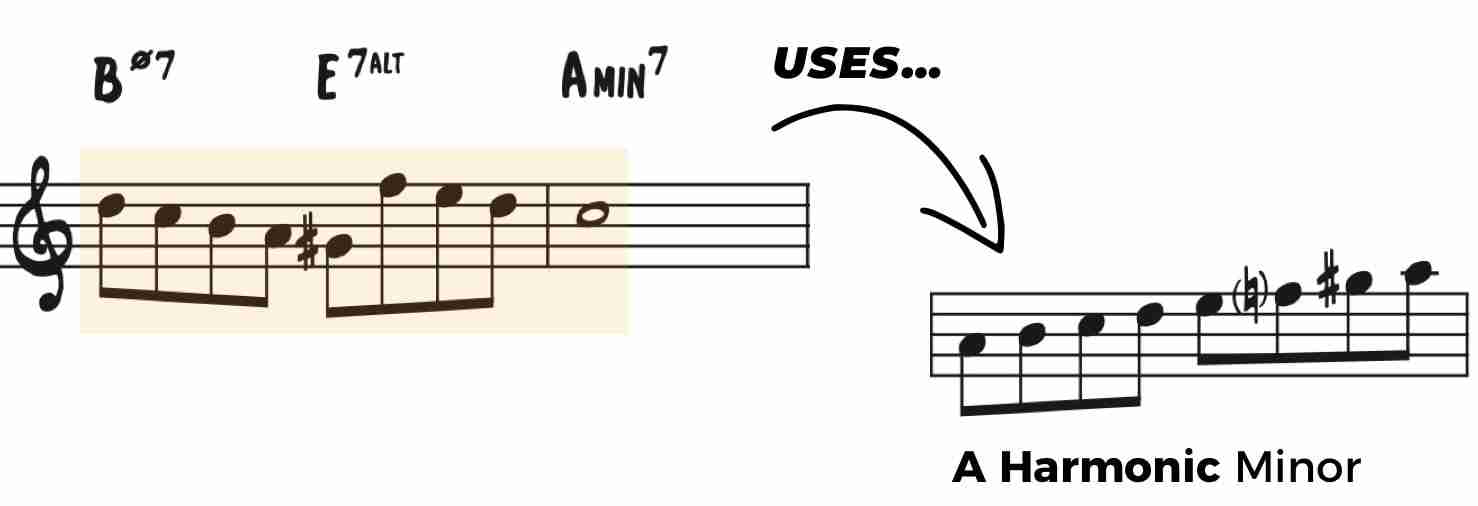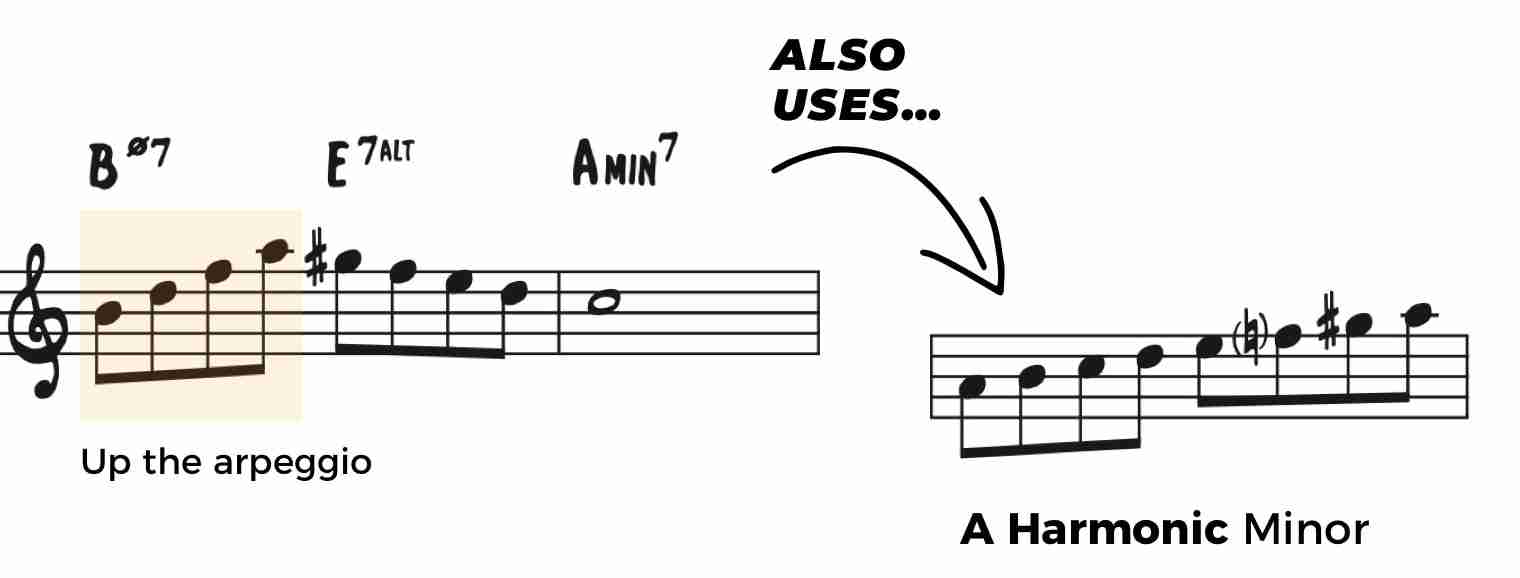For most people, half diminished chords remain a mystery. Also known as minor 7b5 chords, they seem to fall by the wayside, never getting as much attention as major, dominant, or minor chords…
The result: nearly everyone sucks at them
Think about it. Are you as comfortable on Bb half diminished as Bb major? if you’re like most people, probably not. But with the right exercises and a little focus, there really is no reason you can’t be…
Common Approaches to Half Diminished Chords
Part of the reason we don’t perform as well over these type of chords as we would like is that we’ve adopted standard ways to get through them and have not moved past our tried and true methods.
These techniques sound correct, were played by the masters, and are legitimate, the only problem is…they get boring.
This common technique used for minor ii Vs, is what I call the ‘harmonic minor scale trick.’ You simply use language based upon the harmonic minor of the minor tonic you are headed to. Bird used this concept constantly and you probably do too.
Another common way people get by on half diminished chords is by arpeggiating the chord.
Again, not a bad place to start, but at some point you’re going to want to move beyond this.
Always knowing a few sure-fire ways of getting through a chord or set of chords is important, but it is just a starting point.
The goal is freedom. If you are truly free over chords, then you are not limited by the number of phrases you know that ‘work’ over them. In other words, you have gathered a fair amount of workable knowledge that you can implement, that allows you to freely create.
Determine where you’re at
Do a quick test in your mind to see where you are at. It may be surprising.
Pick a half diminshed chord that you feel fairly comfortable with. Now,think of yourself playing over that particular chord. Continue in this manner for about ten seconds…
Now move up a half step and repeat. Continue through all the keys until you’ve gone through all of them.
What did you notice?
Were some easier than others? What was the transition like when I asked you to move up a half-step? Did you have to stop for a second and think about what you would play?
When I did this experiment years ago, it dawned on me that there were four or five that I felt pretty comfortable on and the rest were a shot in the dark.
Could it really be that over half of these chords I barely knew?
Most standards tend to hang around certain keys and therefore, use the same few half diminished chords. What we end up with is seeing the same four over and over, while rarely encountering the other eight, making for a world of pain when we do.
Starting out
When you play the following exercises, do not learn them to reproduce them when you perform. Although they may come out at some point, their purpose is to increase you comfort level and familiarity with the sounds and fingerings over the chords, thereby giving you freedom on the chords to create your own original melodies.
As you know, I’m a big fan of transcribing and I highly suggest you transcribe lines you like over half diminished chords. Use the exercises here to supplement your transcribed lines, not to replace them.
A great way to practice these exercises is to hold down the chord on the piano and hold the sustain pedal, while you play through the exercise.
Pay close attention to how the notes sound against the chord. Practicing in this manner overtime, you will hear the chord in your mind and how each note you are playing functions against that chord, making it unnecessary to have the chord sounded while you play the exercise.
Basic Scale For Half Diminished Chords
Start by playing the Locrian mode up from root. Train your ear to hear the notes in the context of the Locrian scale.
In other words, make sure to hear the tonic of the Locrian scale as the tonic, not the tonic of the parent major scale.
Then play down the Locrian scale in all keys…
Make sure to play the scale full range of your horn and remember, this is just to warm up to get the overall feel for the scale. Just spend a 10-15 minutes refreshing yourself on these.
Basic Patterns for Half Diminished
Next, play the pattern 1234531. Take this pattern up chromatically through all the keys. This exercise will help you get familiar with the diminished triad (ie. B-D-F).
Make sure you are thinking and visualizing the chord and chord-tones while you do these exercises.
Then play the opposite pattern: 5432135
After you play the previous two patterns for a while, connect them for each key like this…
Make sure to practice this over the full range of your instrument and when you reach as you want to go, come down the keys in half steps like this:
And then once you’re comfortable with that, start with the second pattern followed by the first for each key…
Getting to the Meat of the Chord
This exercise will help solidify the most important notes of the chord into your mind, ear, and fingers (The 3rd, 5th, and 7th). It will also help you get comfortable on half diminished chords, which really is the key to being able to improvise over any chord.
Start by playing 3456753:
Then, practice the opposite of that in all keys, 7654357:
And then as before, put it together, so you’ll play 3456753 followed by 7654357.
This is easy if you think of the minor chord based on the starting pitch. So, for B half diminished, think D minor. First your brain will construct shortcuts like this little minor-trick, but after a while the notes will translate to the chord you are working on and you won’t need the shortcut anymore.
Then reverse it…
Again, try sustaining the chord on the piano while you play the exercise through all twelve keys and eventually you will not need the piano backing you up. The chords will naturally begin to function in your ear, allowing you to hear and create your own original melodies.
Transitioning to the altered dominant chord
This exercise will help your ear learn to connect half diminished chords to the chord that typically follows them: the V7alt. chord.
Play 34567537 on the half diminished chord, to 37 on the V7 chord. Continue in this manner, resolving each dominant chord. This will get you through half of the keys, make sure you do the other half.
Not Sucking at Half Diminished Chords
Learning not suck at these chords takes time. Practice these exercises diligently for twenty minutes a day and within just a couple weeks you will find yourself feeling comfortable in all keys on half diminished chords.
Remember, these are exercises to assist in your ability to hear how these chords sound in context, while laying the ground work for your fingers to know where these sounds lay on your instrument. They are not meant to be reproduced verbatim in your solos. Go slowly and let each sound ring in your ear as long as it takes to get it to permeate into your musical mind.
Where to go from here:
- Make up your own exercises similar to these using various combinations of chord tones and scale pieces and remember their purpose.
- Often the flat 9th on a half diminished chord is treated as passing tone due to it’s dissonant quality. Try using the natural 9 (C# on B half-dim) instead of the flat nine and see if you can integrate it in a musical way
- Try playing other chord tones on the altered dominant, perhaps the b5, b13, b9, or #9
- Work on tunes that emphasize half diminished chords such as: Stella by Starlight, Woody’n You, or Inner Urge
- Understand how to play half diminshed chords in different contexts, for instance, in “Woody’n You” the half diminished chords are a part of a minor ii-V, whereas in “Inner Urge” the half diminished chords are on their own for an extended period of time. You may find that you need to approach these situations differently.
- Transcribe some lines of your favorite players playing over half diminished chords
These chords are pretty difficult, so stay tuned and there will be plenty more about how to not suck at half diminished chords in the future.
























